What is all this equipment? Where should Ms. Milton put it?
Page 7: Materials and Devices Used by Students With Visual Impairments
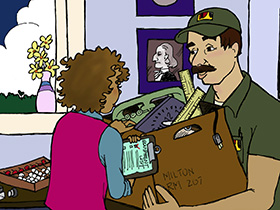 Ms. Milton has received a delivery of equipment for Evan and Emily, and now she realizes that she doesn’t even know the names of most of the equipment, let alone where to put it or how to use it. Even for a seasoned teacher, the vast array of assistive technology available for students with visual impairments can be intimidating.
Ms. Milton has received a delivery of equipment for Evan and Emily, and now she realizes that she doesn’t even know the names of most of the equipment, let alone where to put it or how to use it. Even for a seasoned teacher, the vast array of assistive technology available for students with visual impairments can be intimidating.
assistive technology (AT)
Any item, piece of equipment, or product system, whether acquired commercially off the shelf, modified, or customized, that is used to increase, maintain, or improve functional capabilities of a child with a disability.
With the use of assistive technology, students with visual disabilities have increased access to the same kinds of information their classmates have. Many devices that originally required users with vision, such as computers, notetakers, calculators, dictionaries, and even watches, are now equipped to provide speech output, braille, or a large print display. It is important to note that not all assistive equipment is “high tech” and that many devices used to improve the functional capabilities of students with visual disabilities are inexpensive and “low tech,” such as the long cane, reading stands, or felt-tip pens.
Click below to view photographs and descriptions of various assistive devices and equipment used by students with visual impairments.
| Optical | |
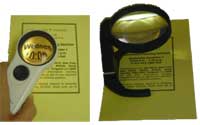 Magnifiers (hand-held, stand) |
Magnifiers use lenses to aid the use of vision by enlarging the image (such as print) that the viewer sees. Magnifiers come in a variety of styles (e.g., hand-held, stand, or mounted on to eyeglasses). |
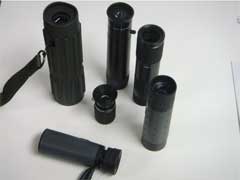 Monocular telescopes |
Monoculars are small telescopes that may be either handheld or attached to eyeglasses. Monoculars may be used to view indoor (e.g., the chalkboard, overhead projections, bulletin boards) and outdoor objects (street signs, addresses, traffic and pedestrian lights). |
  Eyeglasses |
Eyeglasses may be equipped with a variety of lenses that refract (bend) light and bring it to focus on a person’s retina. Two common types of lenses include plus lenses and minus lenses. Plus lenses aid vision by correcting farsightedness. Minus lenses aid vision by correcting nearsightedness. |
| Nonoptical | |
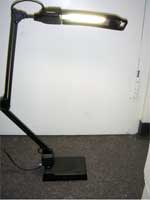 Lamps |
For some individuals with low vision, lamps may aid their use of vision by increasing the illumination of the object being viewed. The amount of illumination for comfortable viewing may be related to many individual factors, including the type and degree of the viewers’ visual impairment and their personal preferences. In addition to the type of lighting (e.g., fluorescent or incandescent) and the position of lighting (e.g., directly on the task, behind the individual’s shoulder) must be considered when attempting to maximize an individual’s use of vision. |
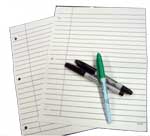 Bold-line paper and felt-tip pens |
Bold-line paper and felt-tip pens are examples of ‘low-tech’ nonoptical devices that aid students with low vision in the development of their writing skills. Writing paper may be individually designed and photocopied by the teacher or purchased commercially. |
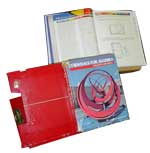 Reading stand |
Reading stands can change the position of the reading or writing surface, increase comfort in the viewing position, and/or reduce overhead lighting glare for students with low vision. |
 Writing guide |
Made out of cardboard, plastic or metal, writing guides come in rectangular forms of various sizes, and each have a space cut out to allow signatures or other information to be written within their boundaries. Many blind people use such guides to sign their names or write checks.
Photo courtesy of http://nfss.stores.yahoo.net/
|
| Electronic magnification | |
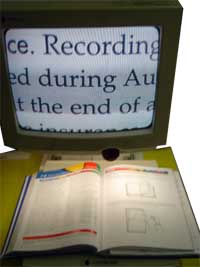 Closed-circuit television (CCTV) |
CCTVs provide electronic magnification using a video camera that projects the image (e.g., reading material, pictures) onto a monitor. CCTVs come in a variety of sizes and styles, including stand (as in the picture) and portable. |
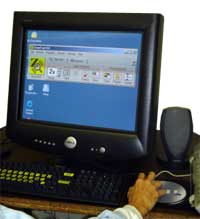 Computer screen magnification |
This computer software provides screen magnification ability, and variable font sizes and types are available. In addition, most computers allow users to choose the color in which text is displayed and the background color shown on the screen. |
| Braille | |
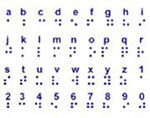 Braille (sample) |
Braille is a code of raised dots arranged in six-dot cells that represent the letters of the alphabet, numbers, and punctuation marks. Braille may be written in uncontracted form, which is letter-for-letter translation, or in contracted form, which is written using abbreviations and contractions.
Photo reproduced with permission from the document entitled “What Do You Do When You Meet Someone Who Can’t See?” from the Lighthouse International website http://www.lighthouse.org
|
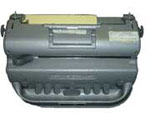 Perkins brailler |
Braillewriters or braillers are similar in function to typewriters and may be manual or electric. The most commonly used in the United States is the Perkins brailler, which is made of heavy aluminum and has six keys, a space bar, and knobs to insert and maneuver the paper. |
 Braille note taker with tactile (or speech) output |
Braille notetakers have braille keyboards and provide spoken and/or tactile output. The user can take notes and compose documents in braille, store the notes in the computer’s memory, and retrieve the notes for spoken or braille output.
Photo courtesy of Freedom Scientific
|
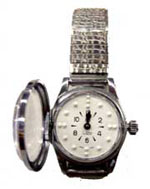 Braille watch |
Braille watches typically have hinged crystals that can be lifted so the user can feel the raised-dot hour markers and hands. |
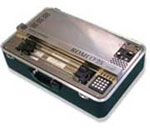 Braille printer and Braille translation software |
The printing of text in braille may be done with a braille embosser. Before embossing, however, the text on the computer must be translated into braille. This is done with braille translation software, which is compatible with many word processing programs.
Photo courtesy of http://www.brailler.com
|
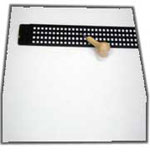 Slate and stylus |
The slate has rows of cells and holds the braille paper. It may come in a variety of sizes; the smaller versions are portable and meant to be carried with the user. The stylus also comes in a variety of models but generally has a pointed end (used to poke the paper and make raised dots) and a rounded end (used as an eraser to rub the dots flat when there is an error). |
 Braille labeler |
The braille labeler works like a print label maker, producing braille on self-adhesive plastic or magnetic tape that can be used to identify books, clothing, or other objects. This allows students to be independent in organizing and using their own materials.
Photo courtesy of http://nfss.stores.yahoo.net/
|
 Refreshable braille display |
Refreshable braille display is an output device that is connected to a computer, often in front of or under the keyboard. It consists of pins arranged in the shape of braille cells that rise and descend to form braille characters.
Photo courtesy of http://www.freedomscientific.com/fs_products/displays_focus40-80.asp“);
|
| Audible/Speech | |
 Optical Character Recognition (OCR) with speech output |
Optical character recognition (OCR) software converts a scanned document into a text file. Reading systems for students with visual disabilities often combine OCR with speech synthesizers (devices that change text into spoken words).
Photo courtesy of http://www.sensorytools.com/galileo.htm
|
 Braille note taker with tactile (or speech) output |
Notetaker keyboards come in braille or standard versions and have features such as synthetic speech output, refreshable braille, and braille translation. Notetakers can usually interface with a regular computer.
Photo courtesy of http://www.freedomscientific.com/fs_products/
|
 Talking calculator |
Talking calculators come in a variety of types and styles, and they perform the same functions as standard calculators. They typically have raised, high contrast buttons, and provide speech output during entry and after calculation. |
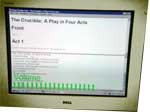 Computer with speech output |
Computers with screen-reading software and speech-synthesis hardware provide students who are blind with the ability to access text on the computer monitor by hearing it spoken in synthesized speech (in either male, female, or child voices). |
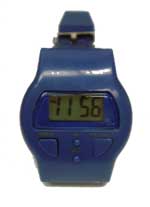 Talking watch |
Talking watches may have either digital or analog displays. With the push of a button, the watch will announce the current time, and some models also announce the day of the week and the date. |
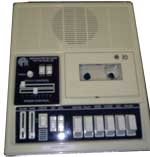 Tape recorder and cassettes |
Tape recorders may be used to record classes or to listen to textbooks, journals, or leisure reading materials. Books on tape are available from a variety of commercial sources and nonprofit organizations. It is important to note that not all audiotapes work on every tape recorder. |
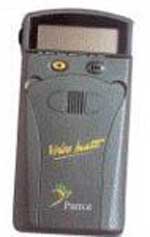 Voice organizer and recorder: Parrot Voice Mate |
Voice organizers and recorders are used to record short notes and messages that can be played at a later time.
Photo courtesy of http://www.enablemart.com/default.aspx?store=10‘);
|
| Optical | |
 Monocular telescopes |
Monoculars are small telescopes that may be either hand held or eyeglasses. |
| Nonoptical | |
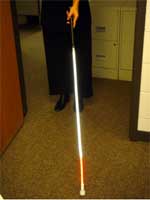 Long cane |
The long cane is a mobility device for individuals who are blind or who have low vision. When used properly, canes help users to detect obstacles, drop-offs, and changes in ground surface. |
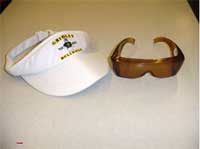 Visor and sunglasses |
Wide-brimmed visors or hats are often used during O&M lessons to assist in controlling glare for students who have low vision. Sunglasses are used to provide ultraviolet protection from the sun’s rays and to remediate the impact of glare upon individuals with low vision who are sensitive to bright light. |
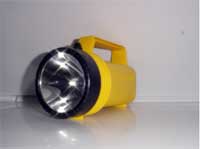 Flashlights |
Flashlights can provide additional illumination at night and in dimly lit environments. Students who experience night-blindness may have particular need for flashlights. Wide-beam flashlights are often used to light the path of travel and look for landmarks. Narrow-beam flashlights are often used for tasks such as reading street signs and addresses.”); |
| Orientation aids | |
 Compass |
Braille and talking compasses serve to provide navigational assistance for individuals who are visually impaired. Individuals who use braille compasses can identify North and the other directions by feeling the position of the raised arrow on the face of the compass via braille letters. Talking compasses typically announce the direction in which the compass is pointed.
Photo courtesy of http://sensorytools.com/c2.htm
|
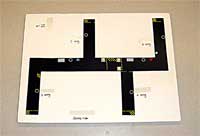 Tactile map |
Maps provide a tactile-visual representation of the spatial layout of environments such as classrooms, hallways, neighborhoods, and cities. Because children who are blind or who have low vision may have difficulty seeing or conceptualizing large environments, the use of tactile maps can enable them to develop the ‘big picture’ of surroundings beyond their immediate perception. |
 GPS receiver |
Global positioning satellite (GPS) receivers can relay information from GPS satellites and inform travelers who are visually impaired of their current location. Used with a portable computer and map software, travelers can review the street layout of unfamiliar areas and can plot the route – including distance and directions – to destinations.
Photo courtesy of Sendero Group – http://www.gps-talk.com
|
Activity
Help Ms. Milton decide which devices are for Emily and which are for Evan. View the Activity.